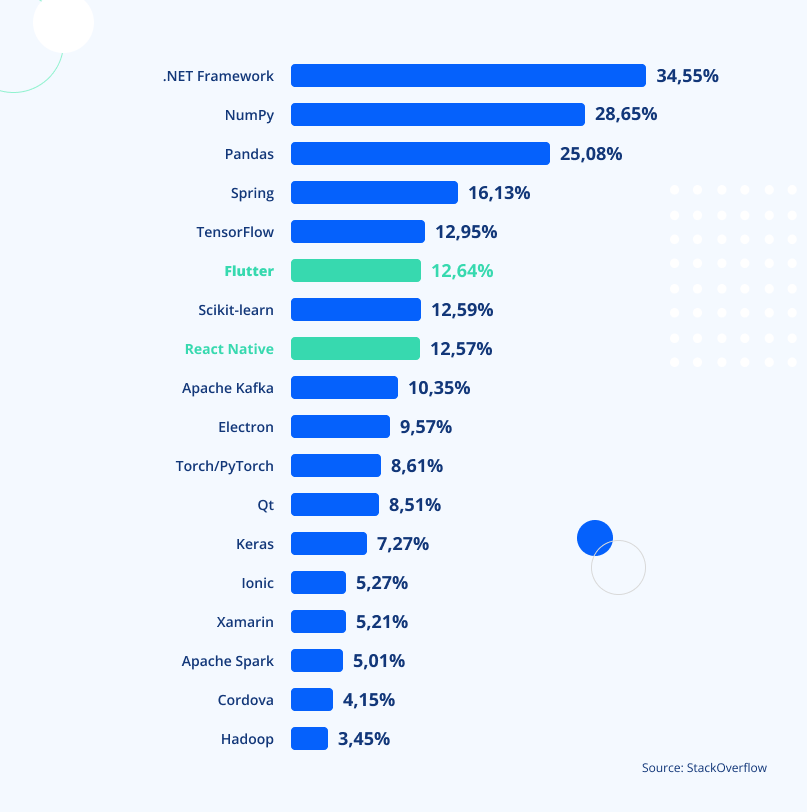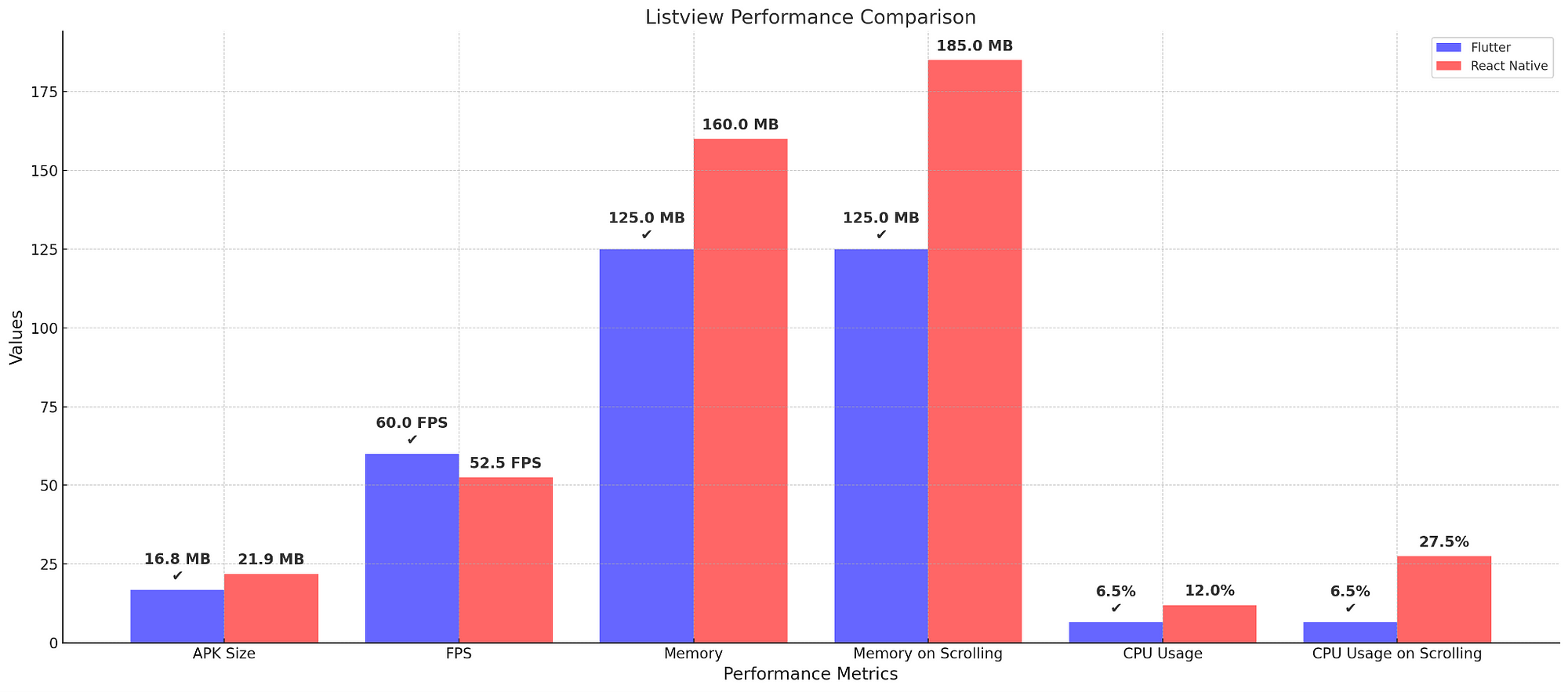Are you trying to decide between React Native and Flutter for your next mobile app project? You’re not alone.
Choosing the right framework can make all the difference in your app’s performance and your overall development experience. In this post, we will dive into the performance aspects of React Native and Flutter, giving you clear insights that will help you make an informed choice.
Imagine your app running smoothly, impressing users with its speed and reliability. That’s the ultimate goal, right? We know how crucial performance is to you, and that’s why understanding the subtle differences between React Native and Flutter is so important. By the end of this article, you’ll have a better grasp of which framework aligns best with your performance needs, giving you the confidence to choose wisely. So, let’s explore what each has to offer and discover which one can help you achieve your goals.

Platform Overview
React Native is a framework by Facebook. It helps create mobile apps using JavaScript. Developers love its reusable components. These components save time. Apps work on both iOS and Android. React Native uses a bridge to communicate with native APIs. This makes apps feel native. But, the bridge can slow down performance. Many developers use third-party libraries. These libraries help add extra features.
Flutter is a framework by Google. It uses the Dart language. Flutter creates apps for iOS and Android too. Apps look the same on both platforms. This is called cross-platform development. Flutter does not need a bridge. This makes it fast and smooth. It has a rich set of widgets. Widgets make designing easy. Apps built with Flutter are often beautiful and responsive.

Development Experience
Setting up React Native is straightforward. Developers use JavaScript, a common language. Flutter uses Dart, which is less common. It requires more steps to install. React Native offers good documentation. This helps in quick setup. Flutter also has guides, but they can feel complex. Both tools need Android Studio or Xcode for setup. This makes the initial process similar. React Native provides smoother start for beginners.
React Native has a gentle learning curve. It uses JavaScript. Many developers know this already. Flutter uses Dart, which is new for many. This can be challenging. Learning Dart takes time. React Native offers a familiar environment. Flutter requires understanding new concepts. Both have active communities. They offer help and resources. But React Native is easier at first.
Architecture Differences
React Native uses a bridgeto communicate with native modules. JavaScript code interacts with native components using this bridge. This can sometimes cause a delay. Native components are written in Javaor Objective-C. The bridge helps them talk to the JavaScript code. Sometimes, this makes the app a bit slower. But it is flexible and easy to use.
Flutter uses a single codebasefor all platforms. It does not need a bridge like React Native. Instead, it uses the Dartlanguage. Dart compiles directly to native code. This makes Flutter apps fastand smooth. The UI components are part of the Flutter engine. This means fewer delays and better performance.
Ui And Design
React Native offers many customization optionsfor developers. It uses JavaScript, allowing more freedom in design. Flutter, on the other hand, uses Dart language. It has its own set of widgets. This makes it easy to create unique designs. React Native allows use of third-party libraries. Flutter offers a rich set of widgets for customization.
Flutter provides many pre-built components. These components help in faster app development. React Native also has pre-built components. But, it relies more on third-party libraries. Flutter’s components are consistent across platforms. This ensures a uniform look. React Native components may vary by platform. Flutter’s Skia engine helps in smooth UI transitions. React Native uses native UI components. This can affect performance.
Performance Metrics
React Native apps load fast. Flutter apps are also quick. Both frameworks aim for smooth user experiences. React Native uses native components. Flutter builds everything from scratch. This affects speed. Flutter can be faster in some cases. React Native relies on JavaScript bridge. This can slow down responsiveness. Flutter has a direct approach. It often feels more responsive. App performance varies based on app complexity. Smaller apps perform similarly. Larger apps need careful planning for speed.
Memory usage is crucial for app performance. React Native and Flutter handle memory differently. React Native uses native components. This can increase memory usage. Flutter compiles everything into native code. It can be more efficient. Memory usage depends on the app size. Larger apps need more memory. Developers should monitor memory use. Both frameworks offer tools for this. Efficient memory use leads to better performance. Users notice when apps are slow.
Community And Ecosystem
React Native has a large number of libraries. These libraries help developers build apps faster. Many developers have created these libraries over time. Flutter also has libraries, but fewer than React Native. The libraries in Flutter are growing. They are becoming more helpful. Choosing between them depends on your needs.
The React Native community is very large. Many developers share their knowledge. They help each other solve problems. Flutter’s community is smaller but very active. They are passionate about improving Flutter. Both communities offer great support. Which one is better? It depends on what you need.
Cross-platform Compatibility
React Native and Flutter both work on iOS and Android. But there are differences. React Native uses native components for a smooth feel. Flutter creates its own widgets. This can make it look different on each device. React Native might be better for those who want a native look. Flutter might be better for those who want the same look everywhere. Both can handle most apps well. But some apps might need special tuning. Always test on both platforms for the best results.
Both frameworks can extend beyond mobile. Flutter has built-in support for web and desktop. This makes it easy to share code across platforms. React Native focuses more on mobile but can work with web through extra tools. This might need more setup. Flutter’s approach can save time. Especially when you want a similar look everywhere. React Native might need more effort for web apps. Choose based on your project’s needs.

Real-world Applications
React Native and Flutter offer unique strengths in real-world apps. React Native excels in seamless updates and existing app integration. Flutter stands out with high-performance graphics and fast development. Both frameworks provide robust solutions for cross-platform mobile development.
Popular Apps Using React Native
React Native powers many well-known apps. Facebook uses it for its mobile app. Instagram also runs on React Native. This tool helps developers save time. Airbnb used React Native for a while. The framework makes updates easy. Discord is another app using React Native. It supports chat and voice features smoothly. React Native helps companies build fast apps.
Popular Apps Using Flutter
Flutter is popular among new apps. Google Ads app uses Flutter. It helps manage ad campaigns easily. Alibaba also uses Flutter for its app. The framework allows smooth animations. Hamilton Musical app runs on Flutter. It offers interactive features for fans. Flutter gives developers a wide range of tools. These tools make apps look good. Many startups choose Flutter for new projects.
Future Prospects
Both React Nativeand Flutterare growing fast. New features are released often. React Native is working on a new architecture. This will make apps run smoother. More updates will improve its speed. Flutter is adding support for desktop apps. This means you can build more types of apps with Flutter. It also aims to improve the user interface. Both frameworks have strong backing from big companies. This ensures they will stay relevant.
Many developers use these frameworks. They are popular for building mobile apps. Tech companies like them for their cross-platform capabilities. This means one codebase works on Android and iOS. The demand for mobile apps is rising. Both frameworks will keep improving. New tools and libraries are being developed. This will help developers create better apps. The focus is on speed and user experience. Companies want apps that load fast and look great.
Frequently Asked Questions
Which Is Faster: React Native Or Flutter?
Flutter generally offers better performance due to its native compilation capabilities. It uses Dart language, which compiles directly into native code. React Native relies on a JavaScript bridge, which may introduce latency. However, performance can vary depending on the specific use case and optimizations applied.
Does Flutter Outperform React Native In Ui Rendering?
Yes, Flutter often outperforms React Native in UI rendering. Flutter’s Skia graphics engine renders UI components directly onto the screen, resulting in smoother animations. React Native uses native components through a bridge, which might affect rendering speed. Flutter’s approach provides more control over UI design and performance.
How Do Flutter And React Native Manage Memory?
Flutter generally has efficient memory management due to its compiled nature and use of Dart language. It can handle complex animations and UI without excessive memory usage. React Native manages memory through JavaScript, which might lead to higher memory consumption, especially in resource-intensive applications.
Is Flutter Better For Complex Apps?
Flutter is often better for complex apps requiring advanced graphics and animations. Its native compilation and rich widget library help handle intricate UI designs efficiently. React Native can manage complex apps but might need more optimizations to achieve similar performance levels, especially with advanced graphics.
Conclusion
Choosing between React Native and Flutter depends on your needs. Both frameworks offer unique strengths. React Native excels in community support and JavaScript use. Flutter shines with its rich UI and performance. Consider project requirements and team expertise. Evaluate the learning curve and development speed.
Both tools are effective for mobile app development. Your choice should align with project goals. Keep future updates and support in mind. Understanding these factors helps in making the right decision. Both can create high-quality apps. Focus on your project’s specific needs for the best outcome.
Read More:
- Network Automation Tools ROI: Boosting Efficiency & Savings
- Noise‑Cancelling Earbuds Battery Life: Maximize Your Usage
- Ci/Cd Pipeline Tools Comparison: Boost Your DevOps Efficiency
- Serverless Vs Containerized Workloads: A Comparative Guide
- Vr Content Creation Tools 2025: Revolutionize Your Creations
- Best Gaming PC Build under $1500: Ultimate Performance
- Best Cross‑Platform Mobile Frameworks 2025: Top Picks
- Javascript Frameworks Benchmark 2025: Speed & Performance

